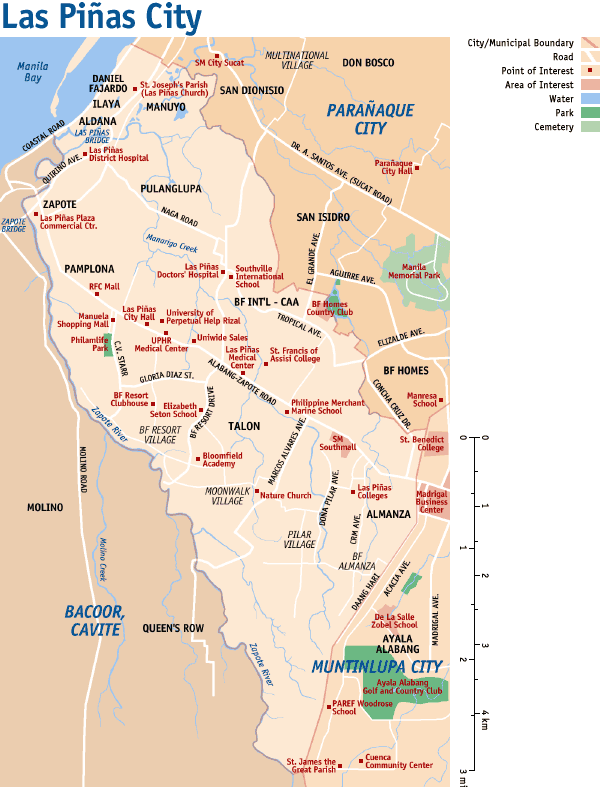|
|
Las Piñas City is one of the cities and municipalities that comprise Metro Manila in the Philippines. It is bordered on the northeast by Parañaque City, by the municipality of Bacoor in the province of Cavite to the southwest, by Muntinlupa City to the southeast, and by Manila Bay to the northwest.
REPUBLIC OF THE PHILIPPINES
2000 census—472,780.
Ph_locator_ncr_laspinas.png
Image:Ph_locator_ncr_laspinas.png
Las Piñas is famous throughout the world for its Bamboo Organ, the only organ of its kind in the world. This is a fully wooden organ that uses bamboo for its pipes. Since its establishment as a small fishing port and a major salt-making center during the Spanish Era, Las Piñas has grown into an important residential and industrial suburb of Manila.
| Contents |
The City
Las Piñas City is located on the southwestern corner of Metro Manila just north of the province of Cavite. Its southern border with the town of Bacoor in Cavite lies at the center of the Zapote River and Manila Bay shapes the city's northwestern border. The total land area of the city is 41.54 square kilometers. Most of the land in the northwestern portion along Manila Bay is marshland. The terrain is relatively flat and sits on centuries of alluvial deposit.
The city is bisected by the Alabang-Zapote Road, previously known as Real Street. It forms part of the Maharlika Highway which spans the whole country. The Alabang-Zapote Road connects the South Luzon Expressway which passes through Muntinlupa City in the east to the Coastal Road along Manila Bay. The Coastal Road, despite its name, is a major tollway which runs the southern length of Metro Manila's shoreline with Manila Bay. It is an important artery for people commuting to and from Las Piñas and Cavite to Manila. In 2004, a new highway (Daang Hari) was completed in the eastern part of Las Piñas, which connects Las Piñas to the neighbouring towns of Bacoor (Cavite), Muntinlupa City, and San Pedro (Laguna), allowing residents to avoid heavy traffic in the Zapote and Alabang (Muntinlupa) districts. Daang Hari is a popular route for cyclists, especially on weekends.
Population
Las Piñas City has a population of 472,780, according to the 2000 Census. Most of the residents are of Tagalog descent.
Education, Culture, and Sports
Educational Institutions in Las Piñas City
- AMA Computer College
- University of Perpetual Help of Rizal
- Saint Francis of Assisi College System
- Southville International School and Colleges
- Las Piñas Colleges
- Philippine Merchant Marine School
- Dr. Felimon C. Aguilar Memorial College
- Informatics Computer Institute
- STI College of Computer Science
- Elizabeth Seton School
- Bloomfield Academy
While Las Piñas City does not have educational might of colleges and universities found in Manila and Quezon City, it does have many educational centers often in specialized academic fields. The most notable university system in the city is the University of Perpetual Help Rizal (UPHR). This university is known for its excellence in Medicine, Nursing, and Law. The UPHR operates the Perpetual Help Medical Center, one of the leading hospitals in the southern part of the metropolis.
The college and high school departments of the Southville International School and Colleges is also located in Las Piñas. This is one of the more well-known international schools in Metro Manila which is also WASC accredited. The Department of Education considers it as a "School of the Future".
Government
Like other cities in the Philippines, Las Piñas City is governed by a Mayor and Vice mayor elected to three-year terms. The Mayor is the executive head and leads the city's departments in executing the city ordinances and improving public services. The Vice mayor heads a legislative council, which is in charge of creating the city's policies. The current mayor is Mayor Imelda Aguilar.
Las Piñas City, being a part of the Metro Manila region, has its mayor in the Metro Manila Council headed by the Metro Manila Development Authority (MMDA). This council formulates development plans that seeks to solve the problems and improve the conditions in the metropolis.
Las Piñas City is divided into 20 barangays (the smallest local government units) which handles governance in a much smaller area. These barangays are grouped into two legislative districts each with its own set of councilors in the city council. District I is located in the northern half of the city while District II occupies the remaining half. Las Piñas is also its own lone congressional district with one representative in the House of Representatives.
District 1 Barangays
- Daniel Fajardo
- Elias Aldana
- Ilaya
- Manuyo Uno
- Manuyo Dos
- Zapote
- CAA-B.F. International
- Pulanglupa Uno
- Pulanglupa Dos
- Pamplona Uno
- Pamplona Tres
District 2 Barangays
- Almanza Uno
- Almanza Dos
- Pamplona Dos
- Pilar Village
- Talon Uno
- Talon Dos
- Talon Tres
- Talon Cuatro
- Talon Singko
The Manila-Cavite Expressway (Coastal Road) with the dominating skyline of Metro Manila
History
Las Piñas was one of the earliest fishing settlements on the shores of Manila Bay.
It became a separate municipality from Parañaque on March 27, 1907 by virtue of Philippine Commission Act No. 1625. Then, with the founding of the Metropolitan Manila Area (now Metro Manila) in 1976, Las Piñas became one of the municipalities and cities comprising the region.
On February 12, 1997, President Fidel V. Ramos signed the bill declaring Las Piñas a new city. A plebiscite held a month after found the residents in approval of cityhood and Las Piñas became the tenth city of Metro Manila on March 26, 1997.
External Links
- Official website of Las Piñas City (http://www.laspinascity.gov.ph)


